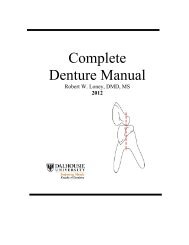RPD Manual 11 - Removable Prosthodontics - Dalhousie University
RPD Manual 11 - Removable Prosthodontics - Dalhousie University
RPD Manual 11 - Removable Prosthodontics - Dalhousie University
Create successful ePaper yourself
Turn your PDF publications into a flip-book with our unique Google optimized e-Paper software.
Surveying, Path of Insertion, Guiding Planes - 14<br />
Surveying, Path of Insertion, Guiding Planes<br />
A path of insertion (or removal) is the path along which a prosthesis is placed (or removed)<br />
intraorally. A removable partial denture is usually fabricated to have a single path of insertion or<br />
removal from the mouth. A single path of insertion is advantageous because it:<br />
1. equalizes retention on all abutments<br />
2. provides bracing and cross-arch stabilization of teeth<br />
3. minimizes torquing forces of the partial denture<br />
4. allows the partial denture to be removed without encountering interferences<br />
5. directs forces along the long axes of the teeth<br />
6. provides frictional retention from contact of parallel surfaces on the teeth<br />
In order to provide a single path of insertion for a partial denture, some axial surfaces of<br />
abutments must be prepared so that they parallel the path of insertion. These parallel surfaces<br />
are called guiding planes.<br />
Guiding planes are prepared wherever rigid components of a partial denture contact abutment<br />
teeth. Specifically, guiding planes should usually be prepared for:<br />
1. Proximal plates<br />
2. Bracing arms<br />
3. Rigid portions of retentive clasps<br />
The dental surveyor is a diagnostic instrument used to select the most favorable path of<br />
insertion and aid in the preparation of guiding planes. It is an essential instrument in designing<br />
removable partial dentures. The act of using a surveyor is referred to as surveying.<br />
Other Uses of a Surveyor:<br />
1. Locating soft tissue undercuts, which can influence the extent of the denture base, the<br />
type of direct retainers and the path of insertion selected.<br />
2. Contouring wax patterns for fixed restorations that will be partial denture abutments.<br />
3. Machining parallel surfaces on cast restorations.<br />
4. Blocking out undesirable undercuts on master casts.<br />
5. Placing intracoronal retainers (precision attachments).<br />
6. Recording the cast position in relation to the selected path of insertion (tripoding).















